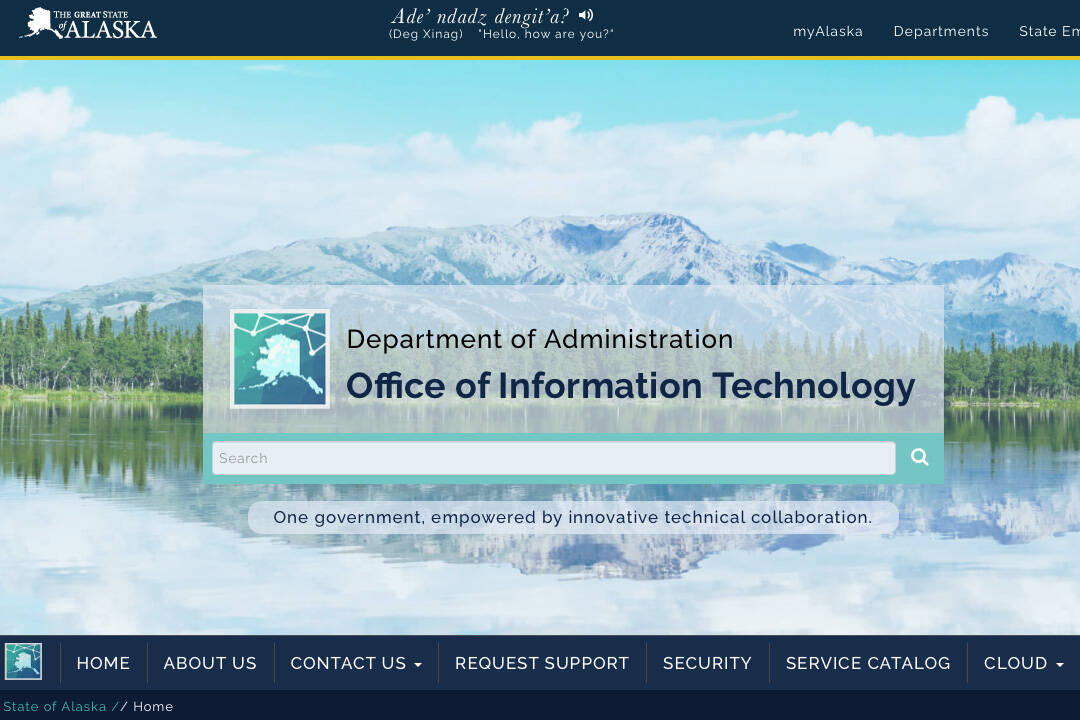By Bill Smith
The Last Frontier has entered a transformational time with several major initiatives to leap even farther forward into the Digital Frontier. In addition to the excitement of the State’s coordinated efforts for delivery of world-class broadband across our great state, the Department of Administration’s Office of Information Technology has spent the last two years executing important and thoughtful preliminary work to move the vast majority of state servers and software applications out of local datacenters and into a cloud environment. By taking advantage of state-of-the-art facilities, this effort will provide increased security around our citizen’s data, more resilience and better reliability, and rapidly modernize Alaska’s technical infrastructure.
At the most basic level, cloud computing is the delivery of computing services remotely. Instead of relying on a server that is in our office or datacenter, cloud computing uses servers hosted in other centralized locations. The State of Alaska has long been using cloud-based systems in the form of hundreds of software-as-a-service applications, and the current large-scale project continues and accelerates the effort to capitalize on the benefits available with cloud computing.
In early 2020, following the decision to modernize, scale and secure the state’s infrastructure with cloud migration, we partnered with industry leaders to evaluate the best path forward and select a solution that was consistent with our current environment. After significant employee training, we began assessing individual applications for movement and moving representative servers to evaluate their performance.
As other states have experienced this ”one at a time” approach, while effective, can be costly and time consuming when it comes to evaluating thousands of state servers and programs. Amid the pandemic response, we identified the need to optimize the process further and began looking for a quicker or more cost-effective approach that would be well suited for our computing needs and goals. Earlier this year, the specific tools needed for just such a rapid migration of our systems were made available in our selected cloud datacenters, setting the stage for the full migration.
The cost of delivery of on-premise infrastructure has increased since we began this journey, and the “Cloud First” strategy is not about matching current capabilities. But instead provides a more cost effective and sustainable vision that upgrades our infrastructure to meet the needs and expectations of our citizens leveraging state of the art technologies beyond our current on-premise capabilities. With the support of the Legislature, we secured funding in the Governor’s 2023 budget and the large-scale migration project kicked off last month. This project is a culmination of the preparation that has been accomplished over the past two years. It involves a close partnership with industry leaders and technology professionals across all the state’s departments.
The migration to cloud based servers represents an important part of the state’s ongoing work to take full advantage of world class security features to protect Alaskans’ data, modernize state information technology systems, and dramatically improve the state’s resilience to unexpected disruption.
The evolution of cybersecurity threats requires immense resources to continuously update and protect computing systems. Migration to the cloud allows us to maintain strict compliance to the latest security standards. Modern cloud providers have tremendous economies of scale that allow them to rapidly adapt to the changing threat, avoiding delays in responding.
The State will be able to increase storage and computing without buying new hardware, provide dynamic disaster recovery by easily locating back-ups in diverse locations, and adjust capacity quickly based on our actual needs. The flexibility inherent in the cloud means less time spent on costly hardware replacement and more time focusing on providing services.
This is an exciting time to work in information technology for the State of Alaska. An increased focus on cloud computing also produces a skill lift for State of Alaska information technology professionals. The use of hybrid cloud environments is commonplace in the modern world and allows professional growth and skill development among the State of Alaska workforce. Our IT professionals will continue to manage and maintain our servers; they also will develop a skillset in cloud storage, application, networking, and management solutions. This is an amazing opportunity for the future of the Cyber community and if you are looking for an opportunity to join a state-of-the-art team, please watch Workplace Alaska for current and future career opportunities.
As we complete the next 18 months of migration, we are focused on modernizing the state’s infrastructure to provide even greater security for individual Alaskans’ data. Although at times it seems transformation can’t happen soon enough, it’s very much worth it. Through this far-reaching project, the State of Alaska will see enhanced security as well as many other benefits in terms of scale, performance, and innovation that comes with cloud computing.
Bill Smith is chief information officer, State of Alaska, Department of Administration, Office of Information Technology.

